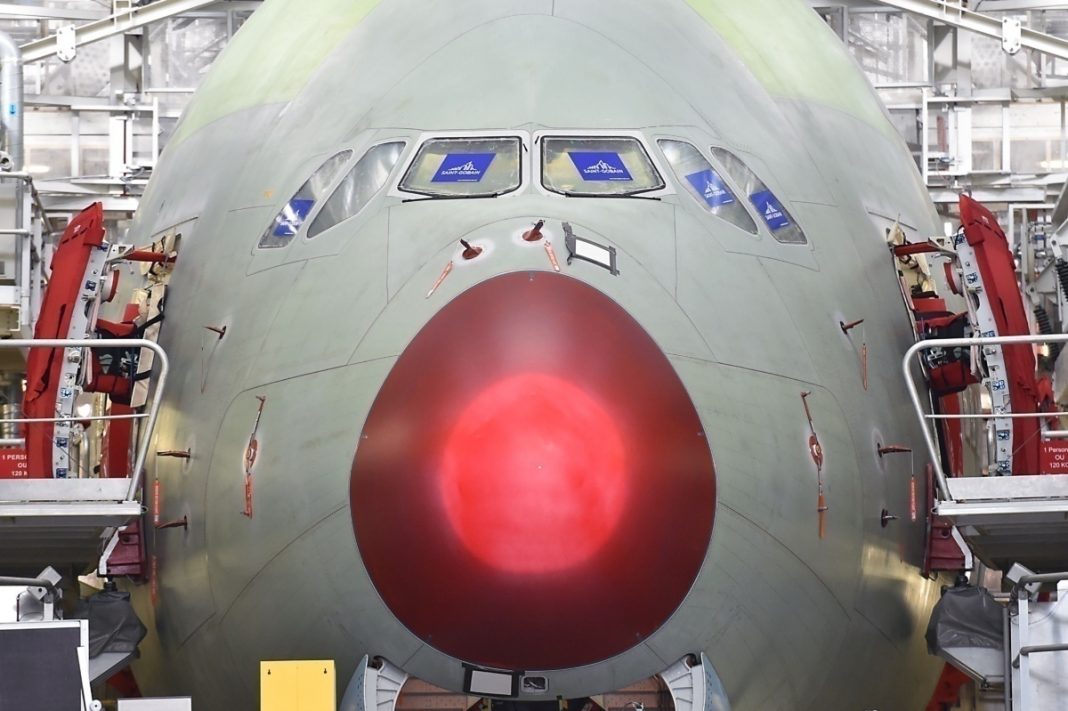With the last planes now being delivered to airlines and production officially complete, we can look back at the A380 project. While the superjumbo set many records for its size and scale, building the aircraft was no easy feat. The aircraft required parts from dozens of companies that had to be transported by land, sea, air, and barge.

Supply chain
Building the A380 required Airbus to create an intricate supply chain of manufacturers. A single A380 requires over four million parts, which are made by 1,500 companies spread over 30 countries across the globe. The production requires a workforce of thousands, spread across different facilities.
While it would be difficult to list every facility and manufacturer of A380 parts, we’ll focus on the largest ones. Starting with the engines, these come from either Rolls-Royce or Engine Alliance (a joint venture between GE and Pratt&Whitney), which provide four Trent 900s or GP7200s, respectively. They come prepared from the manufacturers and are delivered to Toulouse for final assembly onto the A380.

The fuselage of the A380 is made in sections at different places. The nose and center sections are made in nearby Saint-Nazaire, France, while the aft fuselage comes from Hamburg, Germany (along with the vertical tail fin). The A380’s wings are made in Broughton, England, along with most of the other Airbus planes too. Meanwhile, the horizontal tail fins are made in Cadiz, Spain.

While major components are built in neighboring European countries, other parts of the A380 are made in other places. For instance, the wingtips are made by Australian aerospace firm Hawker de Havilland, according to FlightGlobal. But how do these parts make it to the final assembly line?
Transportation
Airbus’ next big step after setting up manufacturing is to transport these various parts. While smaller parts can simply be flown or commercially shipped, the larger ones require dedicated operations. To transport the various parts, Airbus has four main methods: road convoy, ships, air freight, and barge.

The map above highlights how each part of the A380 makes it from the manufacturing facility to the Final Assembly Line in Toulouse. Most parts find themselves moved by a combination of ships (or roll-on/roll-off) and road convoys. However, some unique parts also find themselves on a barge along rivers during their journey.
One notable transport has been of the road journey A380 fuselage from Saint-Nazaire to Toulouse. Residents of small French towns and villages along the path routinely had the chance to see the massive sections moving down the street every few weeks.
However, this came to an end in June, when the last fuselage section made its way through Gers, Leignac, and many more towns, for the last time. With A380 fuselage production now complete, this sight will be no more.

One link missing in the map is the journey the tail fin makes from Hamburg to Toulouse. The fin is actually transported by air on the Airbus Beluga, a supersized transporter made to carry aircraft parts. Despite the massive size of the Beluga (based on the A300), other A380 parts are still too large to be carried on the aircraft.

It all comes together
After long journeys, all the parts are delivered to Airbus’ sprawling facility in the town of Toulouse in southern France. The Airbus A380 Final Assembly Line (FAL) spans over 1.6 million square feet. While the exact number of employees at the FAL is unknown, the entire Toulouse plant employs 48,000 people.

Once all the parts arrive, assembly begins in a single combined station. Scaffolding is erected to join all the major parts once they are lifted into position by cranes. This station sees nearly every part of assembly completed, from the nose to the tail. Only the engine is placed on the aircraft outside this station at the end of production. The reason for this is trying to keep inventory costs low due to the value of the A380 engine (which was once $25 million each).

Once assembly is complete, the plane can be towed outside to begin a series of mandatory checks before its first flight. Tests are conducted on the electrical and hydraulic systems, landing gear, fuel tank (for leaks), and more. Once the plane has completed its test flights, it makes its way into the paint shop to receive its distinct livery (although the tail does come painted).
What now?
While A380’s journey was already quite short, this year’s events have ended any hope of it going on for much longer. The final A380 was assembled in late September, officially ending the use of the FAL. While the plane is still undergoing its tests, Emirates has said that it doesn’t plan on taking delivery of it before mid-2022. This means A380s will remain a sight at Toulouse for at least a year more. Currently, six more A380s are pending for delivery, all destined for Emirates.

With production now over, Airbus is transitioning the A380 FAL to make A321s instead. Starting in 2021, the FAL will help reduce the massive A321 backlog Airbus faces and potentially even produce the A321XLR in a few years. While the A380 era may be coming to an end sooner than we hoped, more innovations are coming to aviation. For now, we should take every chance to we can get to fly the remaining A380s before they are gone!
What do you think about the future of the A380? Let us know your thoughts in the comments below!
[ad_2]
Source link


